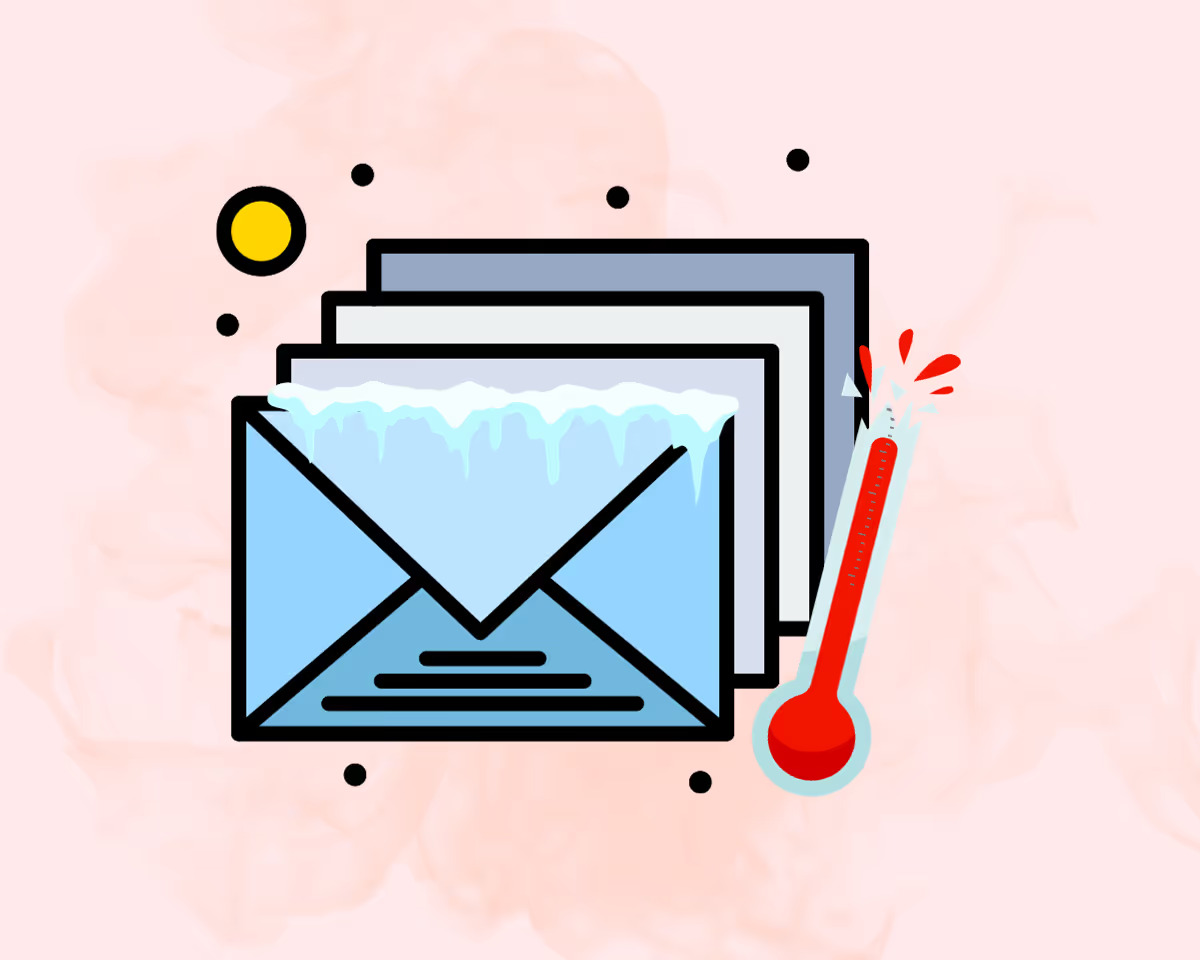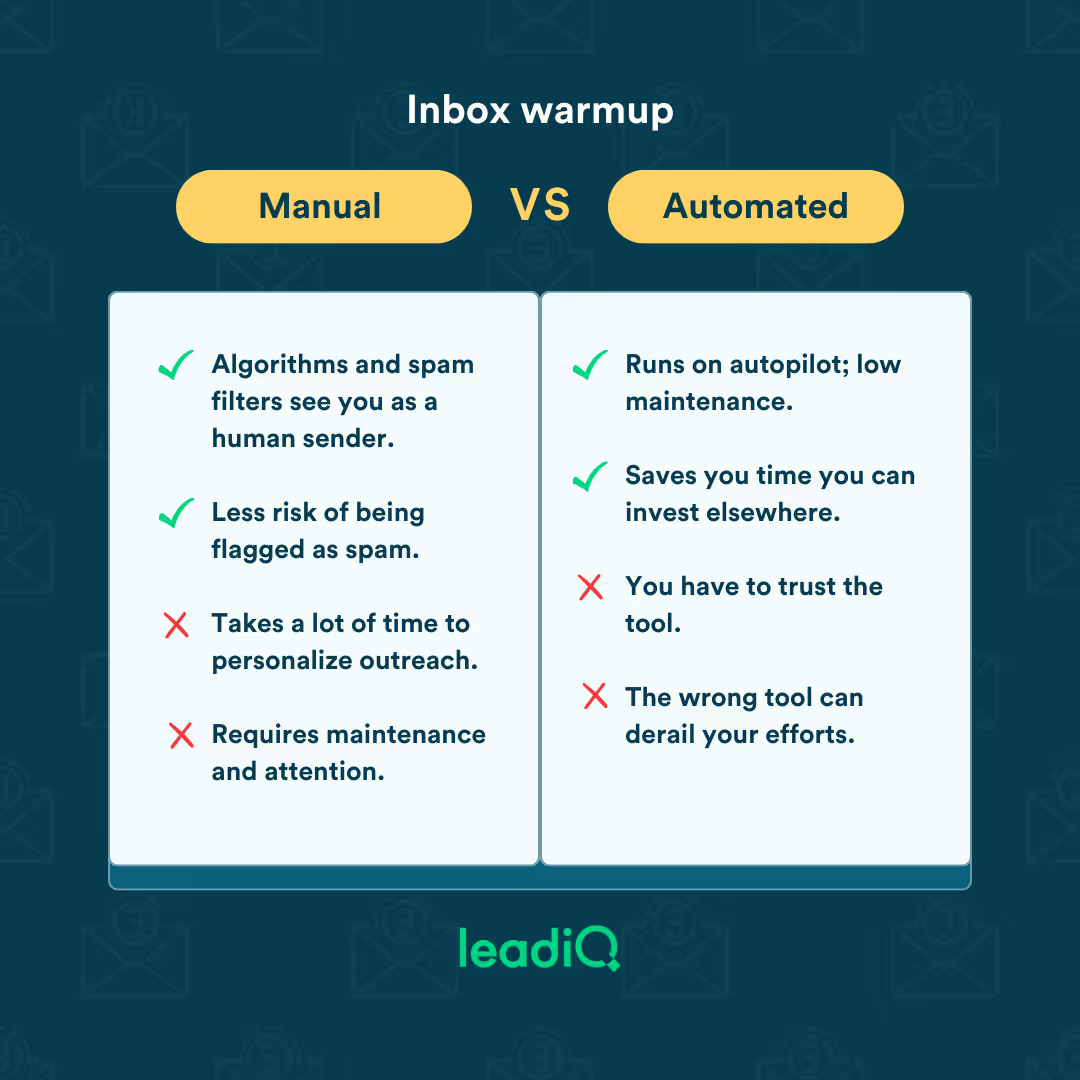Ready to create more pipeline?
Get a demo and discover why thousands of SDR and Sales teams trust LeadIQ to help them build pipeline confidently.



Gmail and Yahoo's new spam rules will impact cold outreach, especially for high-volume senders. Sales teams must adjust their strategies to maintain email deliverability.

Sales teams can establish a positive sender reputation through gradual inbox warmup which can significantly help increase the chances of cold emails reaching the intended inboxes.

Sending personalized, high-value emails to engaged recipients during the warmup phase helps build credibility and avoid spam filters.
Get a demo and discover why thousands of SDR and Sales teams trust LeadIQ to help them build pipeline confidently.
As email providers continue enhancing spam filters to protect users from unsolicited and potentially harmful emails, more and more emails SaaS sales teams send are being blocked from prospect inboxes.
Over the last two decades, we’ve witnessed the rise of basic spam filters, the appearance of user feedback systems, and the emergence of sender authentication mechanisms — like Sender Policy Framework (SPF), DomainKeys Identified Mail (DKIM), and Domain Messaging Authentication Reporting, and Conformance (DMARC) — all of which are designed to minimize unsolicited and malicious messages reaching inboxes.
In just a few weeks, we’ll enter the next phase in the anti-spam era as Gmail and Yahoo’s new spam rules are implemented. As a result, sales and GTM teams who send high volumes of emails will need to adjust their approach to increase the chances their cold outbound sequences end up where they’re supposed to.
While Google has clarified that the update will mostly affect sends to personal Gmail accounts — not Google Workspace accounts — the changes could still have an impact on B2B sales, particularly if reps are trying to reach folks via personal emails or if you haven’t cleaned up your outreach lists to remove generic Gmail accounts.
With the average employee receiving more than 120 business emails every day, inboxes are crowded enough as it is, making it hard for even the best messages to stand out. But if your email never hits the inbox in the first place, you don’t even have a chance of catching a prospect’s attention at all.
Here at LeadIQ, we see these changes as a good thing. After all, sellers should always strive to send authentic, relevant messages to potential buyers — not spam them. When it boils down to it, your outreach should always be highly personalized and provide valuable help and insights that help prospects solve problems.
If you’re worried that upcoming spam changes might thwart your outreach efforts, the good news is that you can increase the chances your cold outreach emails end up where they’re supposed to by prioritizing cold email inbox warmup.
Inbox warmup is a strategic process designed to establish a positive email sender reputation for a new email sender domain or address so that outbound sequences actually end up in recipient inboxes.
For B2B SaaS sales and GTM teams, cold email warmup typically involves sending a series of well-crafted and targeted emails to a small, engaged audience — think champions, partners, and power users — who are more likely to interact with your messages. This calculated approach helps build trust with email service providers by demonstrating authentic, non-spammy behavior on a consistent basis.
Very simply, cold email inbox warmup mitigates the risk of email being marked as spam early, increasing deliverability rates and ensuring that future outbound efforts reach the intended audience’s inboxes instead of being routed to spam folders.
Warming up inboxes for cold email campaigns makes it easier for sales and GTM teams to hit their numbers because it increases the chances outbound sequences end up where they should.
For starters, cold outreach warm-up improves sender reputation by gradually acclimating the sender domain or address to each recipient’s inbox. By taking a strategic approach of sending targeted emails to a small, engaged audience, senders can demonstrate positive behavior, thereby reducing the risk of benign flagged as spam.
At the same time, cold email inbox warmup helps senders avoid abrupt or aggressive outreach, helping solidify a positive sender reputation and increasing the chances cold outreach efforts succeed.
By gradually introducing a new sender domain to an email ecosystem, cold email inbox warmup enhances deliverability. As the sender’s credibility grows, subsequent cold outreach campaigns are more likely to reach the primary inboxes, improving overall deliverability and ensuring messages are seen by the intended audience — which accelerates pipeline.
When it comes to warming up inboxes, there are two main approaches you can take: the manual approach or the automated one.
Using a manual approach to warm up an inbox is a labor-intensive, meticulous yet effective strategy to establish a positive sender reputation and enhance cold email deliverability.
With this approach, senders begin with conservative initial daily sending limits. A rep might send five to 10 emails per day, gradually increasing that volume over several weeks.
If you take the manual route, it’s important to make sure you choose the right recipients. Focus on contacts who are most likely to engage with your messages, and make sure their emails are validated before reaching out.
For the best results, craft compelling, personalized, and non-spammy email content of high value. The goal is to encourage recipient interaction — replies, forwards, clicks, and overall engagement. The more authentic and relevant your emails are, the more likely recipients will engage.
Pros:
Cons:
In the SaaS age, it shouldn’t come as a surprise that there are a number of solutions designed to automate the warmup process for you, including TrulyInbox, Warmup Inbox, Warmy, and Warmbox.
While using these tools can streamline the process, they’re not without their challenges. Potential drawbacks may occur if you don’t configure the tools correctly, risking rapid increases in sending volume that could trigger spam filters and hurt your reputation.
If you opt to go this route, you should still expect to spend time calibrating the tools to balance speed with the gradual improvement of sender credibility. Set and forget at your own peril.
Pros:
Cons:

While spam rules will change any day now, there’s still time to start preparing for the future.
By taking a proactive approach, adjusting your strategy, and fine-tuning the tools you use for outbound prospecting, you can increase the chances that the new Gmail spam filter rules don’t make it difficult for you to hit your numbers.
Interested in learning more about Yahoo and Google’s new spam rules and what you can do to build pipeline in spite of them?
Read some of our latest blog posts about what's changing, how it will affect outbound prospecting, and what your team should do to ensure your messages don't end up in SPAM.